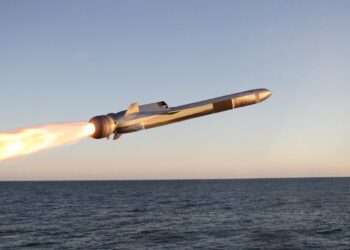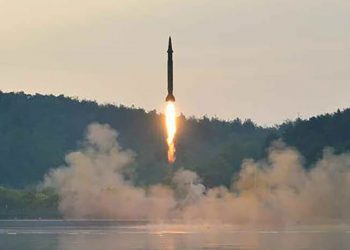,
Moscow: Media reports from the last few weeks increasingly resemble Hollywood horror movies. The United States is reportedly developing a new-generation hydrogen warhead for its Trident II, (D-5) strategic submarines. The Pentagon plans to deploy elements of its National Missile Defense System, namely, an early-warning radar and ground-based interceptor, or GBI, launchers, in the Czech Republic and Poland.
The U.S. Navy is transferring a powerful radar from the Hawaiian Islands to the Aleutian archipelago near the Russian border. Moreover, another radar will be positioned in the South Caucasus, but its exact location is still unclear. In other words, Washington is trying to “contain” Russia.
The American press carries articles about the U.S. absolute military supremacy over Russia and the possibility for the United States to destroy the long-range nuclear arsenal of Russia with a first strike. I mean, above all, an article called “The Rise of U.S. Nuclear Primacy” by Keir A. Lieber, an assistant professor of political science at the University of Notre Dame, and his colleague Daryl G. Press from the University of Pennsylvania, which appeared in the Foreign Affairs magazine. They cite figures which show that Russia's strategic nuclear arsenal has sharply deteriorated.
Unfortunately, one must agree with many points of this article. Moscow's commitment to the July 31, 1991 START I Treaty on the Reduction and Limitation of Strategic Offensive Arms has caused the Russian nuclear arsenal to shrink considerably over the last few years. Furthermore, some combat-ready ICBMs, including the famous Voyevoda R-36-MUTTKh or R-36-M2 — NATO designation SS-18 Satan — with 10 independently targeted warheads, the obsolete RT-2PM Topol mobile ICBM — NATO designation SS-25 Sickle — and some others, are being scrapped.
Russia's strategic nuclear forces now have 762 missiles capable of launching 3,373 nuclear warheads. The Strategic Missile Force wields 503 ICBMs and 1,853 nuclear warheads. The Russian Navy operates 12 strategic submarines with 636 nuclear warheads, and the Air Force has 79 strategic bombers with 8,884 long-range cruise missiles.
The United States, on the other hand, has 5,521 combat-ready nuclear warheads, including 1,050 warheads on 500 silo-based missiles, 2,016 warheads on 336 submarine-launched missiles, and 1,955 long-range cruise missiles for its 100-plus Boeing B-52 Stratofortress and Grumman Northrop B-2 Spirit bombers.
Nonetheless, Russia has enough nuclear warheads to feel more or less calm.
Under the May 24, 2002 Russian-U.S. Strategic Offensive Reductions Treaty, each country may retain not more than 1,700-2,200 strategic nuclear warheads by December 31, 2012.
Moscow continues to reduce and upgrade its strategic nuclear forces. Obsolete missiles are being scrapped and replaced with fewer, albeit more dependable and effective, RT-2PM2 Topol –NATO designation SS-27 — silo-based missiles. The Russian Strategic Missile Force, which now has 45 such missiles, will increase their number to 150 by 2015 under the state rearmament program. Meanwhile, the Navy will receive Bulava-30 — NATO designation SS-N-30 — missiles for its Mk 955 Borei-class submarines.
Part Two
Frankly speaking, it is pointless to calculate the size of the Russian and U.S. strategic arsenals because our two countries have the ability to destroy each other several times over. President John Fitzgerald Kennedy once said that it did not matter whether the United States could destroy the Soviet Union 20 times and the Soviet Union could do the same only three times because once was quite enough.
Russia and the United States, which are no longer divided by any principled and irreconcilable ideological differences, should not revert to the Cold War-era concept of Mutual Assured Destruction (MAD). On the contrary, they should opt for a reasonable approach and jointly deal with high-priority threats, such as international terrorism, the spread of weapons of mass destruction and missile technologies, religious and ethnic intolerance, separatism and extremism, as well as poverty, which fuels terrorism and religious extremism.
The latter is particularly true of Afghanistan. The American-led NATO coalition has been trying to prop up the government of Hamid Karzai for several years, stabilize the country, introduce democratic institutions there and help get rid of the Taliban and Al-Qaeda extremist organizations.
But it turns out that a 35,000-strong NATO force comprising elements of the world's most powerful armies cannot accomplish these objectives. Consequently, the Jan. 31-Feb. 1, 2006, London Conference on Afghanistan and the November 28-29, 2006, NATO summit in Riga decided to continue the peacekeeping operation and said the industrialized world would provide $10.5 billion for Afghan economic development over the next five years. The United Nations, World Bank, European Union, Organization for Security and Cooperation in Europe and some non-governmental organizations will also contribute greatly to this social and humanitarian relief package. Unfortunately, donor aid is often stolen before it can reach Kabul. Moreover, many Afghan companies do not get regular allocations for humanitarian and social projects in Kabul and its environs and are therefore unable to create jobs and raise the living standards of the country's neediest.
Nonetheless, the Bush administration plans to ask Congress to set aside another $10.6 billion for Afghanistan. British Prime Minister Tony Blair has promised to allocate 500 million pounds over the next three years. France, Germany, Japan, China, India, Turkey, Iran and Russia are all ready to provide support.
The Kremlin has pledged to write off Kabul's $10 billion debt to Moscow and to furnish the Afghan army with weapons and equipment for fighting terrorists and extremists. Moscow also trains Afghan police officers to combat trafficking in illegal drugs, which fuels terrorism.
As I see it, reasonable cooperation involving Russia, the United States, NATO and other countries on the Afghan problem and other pressing issues, the Middle East settlement in particular, would prove far more useful than nuclear confrontation and brinkmanship policies. Each country has the right to provide for its self-defense and national security. This, however, should never be accomplished at the expense of other nations.
U.S. efforts to “contain” Russia will not bring calm to Washington because, as President Vladimir Putin has said, Moscow will find a sufficiently cheap, adequate and asymmetrical response to the NMD program. But this does not seem to be a good idea, either, because an arms race cannot help overcome poverty. Russia, the United States and the rest of the world would benefit if the MAD concept were replaced with reason and cooperation.
Viktor Litovkin is a military correspondent for the RIA Novosti news agency. This article is reprinted by permission of RIA Novosti. The opinions expressed in this article are those of the author and do not necessarily represent the opinions of the RIA Novosti editorial board.









